Kanishka
Kanishka was not a Buddhist. It is a later-day myth. (irrespective of what later noncontemporary Buddhist literature says). Buddha features in less than one percent of Kanishka’s own coins. In his own Rabatak inscription, Kanishka venerates the Goddess Nana. Buddha is absent.
Note that Nana was a Goddess worshiped in the Northwest. She was equated to Durga. The locals of Baluchistan still address Hinglaj Mata temple as “Nana(i) Mandir”
Some claim that he organized the 4th Buddhist council in 72 AD. But it is debatable, the so-called “4th Buddhist council” was mentioned by Xuanzang in the 7th century CE. It was not even mentioned by Faxian. Xuanzang gives a date of c. 75 CE. It is doubtful whether Kanishka was even born by this date. Xuanzang also repeats the later legend. Xuanzang also repeats the later mythical legend of Buddha prophesizing the birth of Kanishka and Vasumitra’s magic. Far removed from Kanishka’s lifetime and filled with mythical legends, it is hard to take Xuanzang’s account of Kanishka at face value.
In his own Rabatak inscription, Kanishka called himself “son of the Gods”. This title (proclaiming semi-divinity) is hardly one that an early Buddhist king would use. Buddhist kings like Ashoka and Tissa rather styled themselves as “beloved of the gods” (Devanampriya).
Nowhere in any of his inscriptions does Kanishka call himself “Saugata”/“Paramasaugata”/“Bauddha”, titles which would proclaim his affiliation to Buddhism. Rather, Buddha is completely absent among the Kushan family deities mentioned in the Rabatak inscription. Rabatak inscription is near the Kushan royal sanctuary of Surkh Kotal, in their native Afghanistan. This inscription is very important because it gives us a glimpse into what the Kushans actually believed in, rather than what they patronized among their Indian subjects.
In the royal sanctuary, Kanishka orders his architect to make a temple for these Gods
- “Glorious” Uma (Parvati)
- Mahasena (Kartikeya)
- Vishakha
- Mihira (Mitra)
- Aurmuzd (Ahuramazda)
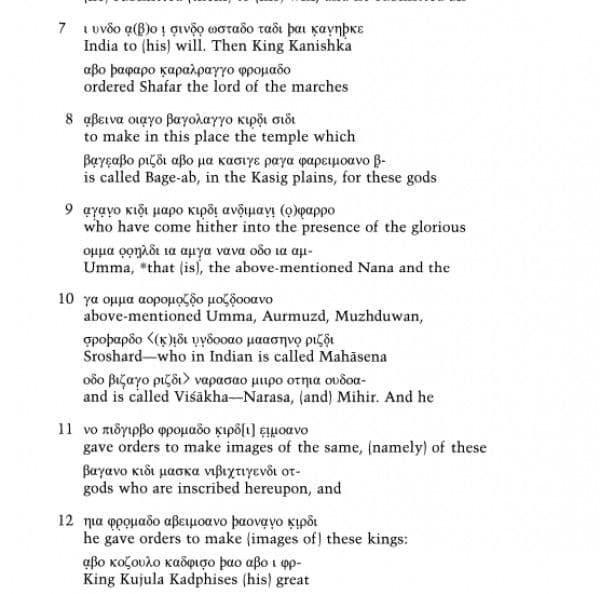
It is clear from this inscription that Kanishka worshiped Shaivite Gods. But he also equated them with his native gods. For example, Kanishka equated Kartikeya with his native Iranic deity Sraosha. Later Kushans equated Nana with Durga. They equated Ardoksho with Lakshmi.
This is not surprising at all. Coverts to Hinduism do not obliterate their past beliefs. Hinduism does not insist on the obliteration of past beliefs. Rather the converts identified their native gods with the Hindu Gods in this process of conversion. This has always been the case.
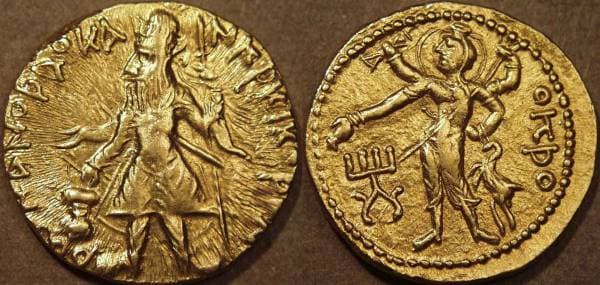
A golden coin of Kanishka. Four armed Shiva holding Trishula, Damaru, and the Deer are depicted. Kushans worshiped Shiva, identifying him with their native deity Oesho. Shiva featured in the majority of Kanishka’s coins.
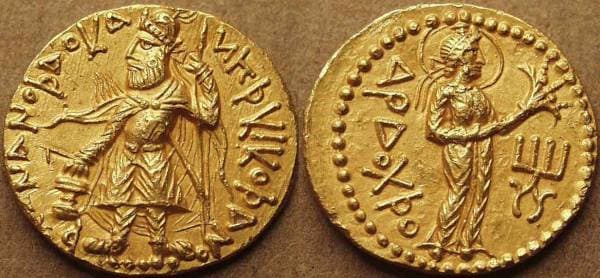
A Bactrian Gold coin of Kanishka. The Goddess Ardoksho is depicted holding a crop. Kushans identified her with Goddess dhānyalakṣmī. Dhānyalakṣmī also holds a crop of paddy in her hands.
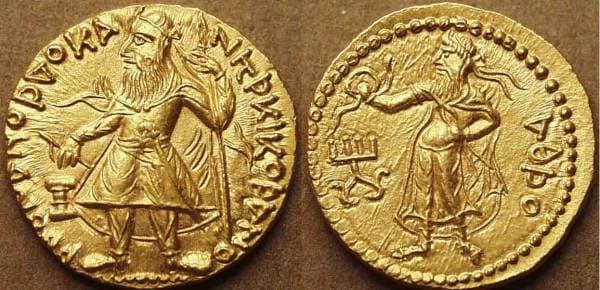
Another Bactrian Gold coin of Kanishka. The Iranic fire God Atar(Atasho) is depicted on this coin. Kushans identified Atar with Agni.
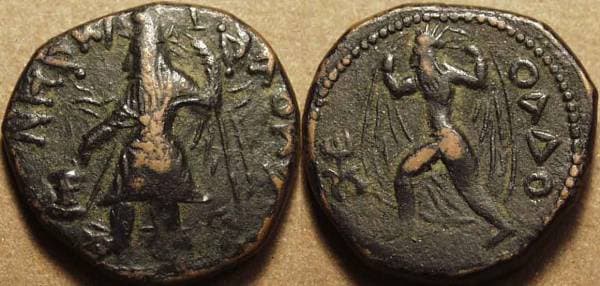
A bronze coin of Kanishka. It depicts the Indo-Iranian wind God Vata. Of course, even the Vedic people worshiped the same wind God Vata-Vayu.
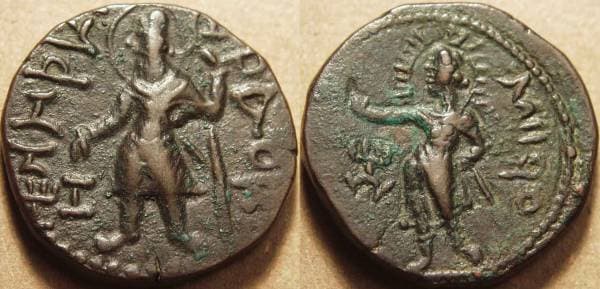
Another Bronze coin of Kanishka. It depicts the Indo-Iranian deity Mitra/Mithra. This God was worshiped by both Vedic people and Iranians.
Kushans were East Iranics by ethnicity. They were not Zoroastrian as they worshiped deities not found in Avesta. As we have seen, Kanishka was not a Buddhist either. He sponsored Peshawar stupa for his Buddhist Gandharan subjects.
There was not much difference in the religious beliefs of Vedic Hindus and (Non-Zoroastrian) Iranic people. This was the “Arya” background of Kanishka. Interestingly, “Arya” was the self-identification of Kanishka. He refers to his native Bactrian language as “Arya” language.
Despite these original records of Kanishka, book after book, article after article has identified him as a devout, zealous Buddhist. Why? Their conception of Kanishka was shaped by late, non-contemporary Buddhist writings which depicted him as a Buddhist.
The Buddhist writers were very habitual in this aspect. They even identified king Harshavardhana as a Buddhist. But we know from his own inscriptions that he was a Shaivite. The Buddhist writers mistook patronage for religious affiliation.
Do note that not all Kushans followed this Indo-Iranian polytheistic pantheon. There were exceptions. Kanishka’s father, the Kushan emperor Vima Kadphises was exclusively Hindu & exclusively Shaivite. He inscribed Shiva on all his coins. No other deity was represented on his coins.
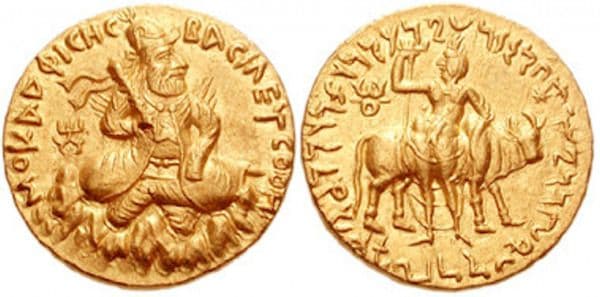
Buddha was not minted by Vima Kadphises. Buddha is the least common of Indian deities to appear on Kanishka’s coin. Buddha was completely ignored on the coins of Kanishka’s successors Huvishka, Vasudeva, and others. The later Kushans succeeding Vasudeva ignored the Iranic deities as well. They depicted only Shiva and Ardoksho (Lakshmi) on their coins. The transformation into Shaivism was complete.
Source: